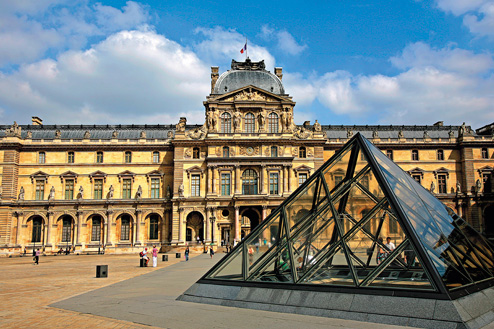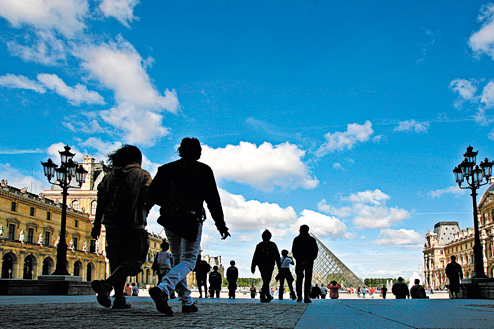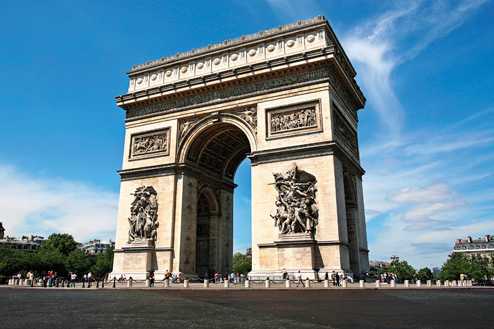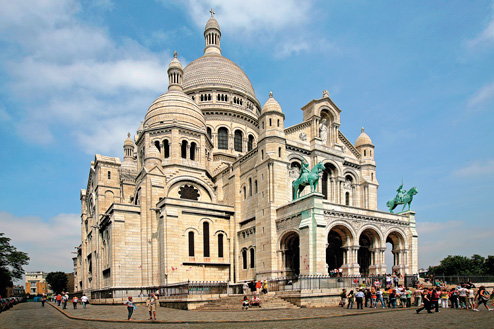The Louvre, Tuileries & Palais Royal
Begun by François I on the site of a medieval fortress, the Louvre grew ever more imposing until Louis XIV upped sticks for the fresh air of Versailles. Luckily for us, the Sun King still found time to commission the transformation of the Jardins des Tuileries , whose curvy stone nymphs and shady cafes make it a favourite spot to saunter or sit. The roar of traffic on Place de la Concorde quickly dies away as you enter this chestnut-lined haven with its wide, gravel paths. To the left of this entrance, the Jeu de Paume, once a real tennis court, holds major photographic retrospectives against a backdrop of slick, modern severity. Roughly opposite, the Musée de l’Orangerie attracts large crowds. Join the Monet pilgrims to see les Nymphéas (waterlilies) in the luminous setting they deserve, or promenade onwards along the gravel avenues. Between the two ponds and their pastel-coloured sailboats, you can pull up a heavy chair and watch the world go by, or relax at one of the laid-back cafes on either side – service is erratic, but the prices aren’t exorbitant.
The greenery ends at Napoleon’s Arc du Carrousel, just about small enough to seem like a dry-run for the two much bigger arches it frames. Opposite, I.M. Pei’s glass pyramid was highly controversial when it was unveiled here in 1986. Nowadays, it’s widely appreciated, not least by the shoppers in the airy Louvre du Carrousel mall below. If you’re Louvre-bound, it’s worth buying tickets in advance inside the mall itself, so you can enter at the less crowded entrance on Passage Richelieu, just off the Rue de Rivoli. If the prospect of steering a course through some 35,000 works of art overwhelms you, bide your time in admiration of the monumental royal palace that houses them. Onwards through the Louvre precinct, the Cour Napoléon and the Cour Carré make a perfect setting for sunset strolls.
In a wing of the Louvre, though separately managed, the fabulously revamped Musée des Arts Décoratifs charts the ongoing history of (mainly French) taste through a vast array of applied arts. Within the same building, you’ll also find the Musée de la Mode et de Textile and the Musée de la Publicité . Though modest compared to the Louvre, these are impressive collections, and you’ll still need to pace your visit.
Kitsch souvenir shops dominate the opposite stretch of the rue de Rivoli, followed by the Antiquaires du Louvre, the place to go if you’ve a taste for fine antiques and the budget to match. Be sure not to miss the Jardins du Palais Royal, tucked away behind the Conseil d’État and the Comédie Française. Enclosed by elegant, three-tiered arcades, this tranquil space was once the haunt of loose women, gamblers and wild entertainments, welcomed in by the democratically-minded (and pleasure-loving) Duc d’Orléans shortly before the Revolution. Parfumiers and antiquarian booksellers have taken their place, while Daniel Buren’s humbug-striped columns add a touch of whimsy to the formal surroundings.
The greenery ends at Napoleon’s Arc du Carrousel, just about small enough to seem like a dry-run for the two much bigger arches it frames. Opposite, I.M. Pei’s glass pyramid was highly controversial when it was unveiled here in 1986. Nowadays, it’s widely appreciated, not least by the shoppers in the airy Louvre du Carrousel mall below. If you’re Louvre-bound, it’s worth buying tickets in advance inside the mall itself, so you can enter at the less crowded entrance on Passage Richelieu, just off the Rue de Rivoli. If the prospect of steering a course through some 35,000 works of art overwhelms you, bide your time in admiration of the monumental royal palace that houses them. Onwards through the Louvre precinct, the Cour Napoléon and the Cour Carré make a perfect setting for sunset strolls.
In a wing of the Louvre, though separately managed, the fabulously revamped Musée des Arts Décoratifs charts the ongoing history of (mainly French) taste through a vast array of applied arts. Within the same building, you’ll also find the Musée de la Mode et de Textile and the Musée de la Publicité . Though modest compared to the Louvre, these are impressive collections, and you’ll still need to pace your visit.
Kitsch souvenir shops dominate the opposite stretch of the rue de Rivoli, followed by the Antiquaires du Louvre, the place to go if you’ve a taste for fine antiques and the budget to match. Be sure not to miss the Jardins du Palais Royal, tucked away behind the Conseil d’État and the Comédie Française. Enclosed by elegant, three-tiered arcades, this tranquil space was once the haunt of loose women, gamblers and wild entertainments, welcomed in by the democratically-minded (and pleasure-loving) Duc d’Orléans shortly before the Revolution. Parfumiers and antiquarian booksellers have taken their place, while Daniel Buren’s humbug-striped columns add a touch of whimsy to the formal surroundings.













